
Dental disease is THE most common ailment we find in dogs and cats.
It is both treatable and preventable when caught early.
DOGS AND CATS HAVE TEETH
But dogs and cats don't brush their teeth. It should therefore not be surprising that they frequently develop dental problems. It's just like your mother used to tell you when you were little: "If you don't brush your teeth, they'll all fall out!" In order to better understand dental disease, lets start with a brief review of the pertinent anatomy. I will use drawings from human dental texts because they are easier for us to relate to. The tooth shapes are different in dogs and cats, but all the parts are the same.
THE ANATOMY OF TEETH
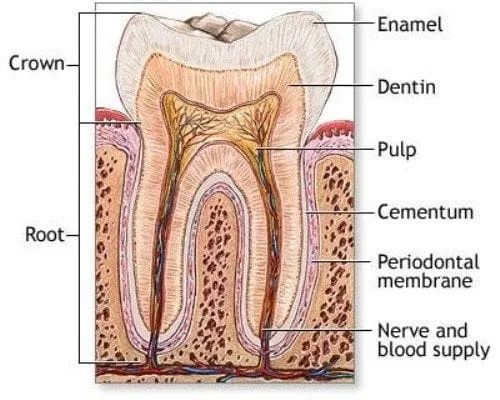
The tooth sits in a socket in the bone of the jaw. It is held in place by its roots. The dentin of the roots is covered with a layer called cementum, which helps cement the
tooth in place. The periodontal membrane, or periodontal ligament as it is more properly called, is a ligament just like any other ligament in the body. The periodontal ligament
is made out of tough connective tissue, and runs between the bone of the jaw and the cementum of the roots, and holds the two together in a strong, flexible, elastic bond. The gums, or
gingiva, cover the bone of the jaw and attatch to the cementum of the roots leaving a small pocket, or gingival sulcus, normally less than 2mm deep in dogs, between the enamel of the crown
and the gingiva.
THE MOUTH IS AN EXCELLENT PLACE FOR BACTERIA TO GROW
Bacteria on the surface of a tooth normally form what is called plaque. Plaque is a biofilm, a thin, translucent film made up of bacteria,
proteins they secrete, and food particles. Normally, plaque is removed soon after it forms by the simple act of chewing. Dog and cat teeth are arranged differently than human
teeth in that most of them do not touch together. That means that chewing is more likely to be an effective way to remove plaque than in people. Not surprisingly, we see the most
problems in places where the teeth do touch together: the incisors in front and between the big molars in back, and in toy dogs where all the teeth are jammed tightly in to a small
mouth.
If plaque is not removed, the bacteria that form it continue to multiply. The plaque gets thicker, and the nature of the bacteria that make it changes to a more sinister
character. The thick persistant plaque will mineralize, forming tartar. Tartar, although it looks like it might be mineral deposits, but it is actually about 80%
bacteria. And unlike plaque, tartar is firmly adherent to the tooth, and neither brushing nor chewing is effective in removing it.
PROBLEMS START TO HAPPEN WHEN TARTAR BUILDS UP
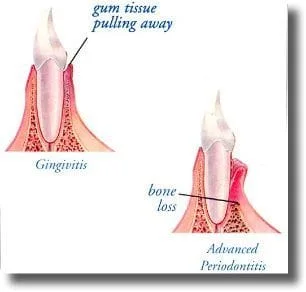
This is especially true when tartar builds up under the gums. In dogs and cats, cavities are not a real problem. This type of decay seldom happens in pets' mouths.
However, the bacteria in tartar make toxins and harmful waste products that can damage the gums and other soft tissues. The inflammation that results from tartar's
interaction with the soft tissues releases other damaging compounds.
In the images to the left, we see brown tartar building up both above and below the gum line, and the tissues are becoming red and swollen because of the inflammation. As the infection
progresses, the gums and soft tissues are eaten away by the bacteria. This is called Periodontal Disease. The gingival sulcus becomes abnormally deep, and is now called a
periodontal pocket. The difference between a gingival sulcus and a periodontal pocket is that in a gingival sulcus (normal), the root is not exposed. In a periodontal pocket
(abnormal), the root is exposed. As the periodontal pocket deepens, soon even the bone itself begins to be resorbed. Then the infection invades the periodontal ligament and
destroys it,and the tooth becomes loose.
THE PROGRESSION OF PERIODONTAL DISEASE IS DIVIDED INTO STAGES.
Although the stages are somewhat artificial, it is nonetheless very useful to classify it this way.
STAGE ONE: MILD GINGIVITIS

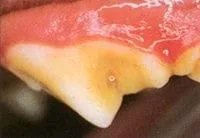
STAGE TWO: EARLY PERIODONTAL DISEASE.
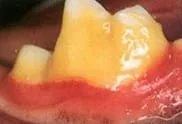
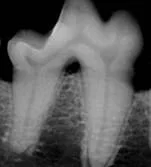
STAGE THREE: PERIODONTAL DISEASE
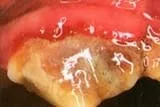

STAGE FOUR: END-STAGE PERIODONTAL DISEASE


A PATIENT CAN HAVE ALL FOUR STAGES AT THE SAME TIME
It is important to remember that any one individual can have some teeth that are perfectly normal, some teeth that are Grade One, some teeth that are Grade Two, some teeth that are Grade Three, and some teeth that are Grade Four, all in the same mouth. It is also important to remember that we can not grade a given tooth accurately unless we both probe and x-ray it. This means that when we examine a patient awake, we are only guessing at what dental problems may be there.
DOES MY DOG OR CAT NEED TO HAVE HIS TEETH CLEANED?
If the question is will your dog or cat die immediately if his teeth are not cleaned, the answer is no. If the question is will your dog or cat be healthier and happier if his teeth are cleaned, the answer is yes.
IN MODERN SOCIETY, ORAL HYGIENE IS PRETTY MUCH EXPECTED FOR CIVILIZED PEOPLE.
Not only has science proven that there are huge health benefits to having clean teeth, it is generally accepted that not brushing in not cool. Periodontal disease has a number of serious complications. Arguably, better oral hygiene is responsible for a large part of the increase in human lifespan we have seen in the last century.
Would your dentist say, "well, Bob, you are developing periodontal disease which will make your breath smell like a sewer, damage your gums, and eat away the bone that supports your teeth till they get loose and wobbly. But why don't we wait till next year when things have gotten a little worse to start treatment?"
Or would your dentist ever say, "well, Jane, your severe periodontal disease is showering your body with bacteria and toxins 24/7 causing kidney and heart disease, but after all, you are pretty old and it may not be worth treating you, if you know what I mean."
I DON'T THINK YOUR DENTIST WOULD SAY THAT!
Infected teeth, or periodontal disease, start out as mild plaque build-up with mild inflammation of the gums, but no deeper involvement and no loss of the supporting bone. There may not even be much visible tartar build-up at this stage, and the teeth may appear quite white and normal. However, there will be a red line at the margin where the gum meets the tooth. This red is the same red we see when a cut or scratch gets infected, and is called inflammation. The red tissues may bleed easily when touched. There may be a bad odor, and translucent plaque may be visible. This is called Stage I Periodontal disease.
As periodontal disease advances, the infection works it's way down deeper along the tooth roots. Stage II Periodontal Disease involves loss of up to 25% of the boney support of a tooth. This is where we start to find deep pockets in the gums around teeth when probed with a dental probe. There is often visible brownish tartar, and the odor is stronger. The teeth are not yet loose.
There are more stages of periodontal disease, but I'm going to stop here. Why? Because for our purposes, only the first two matter. This is because only Stage I Periodontal Disease is truly reversible. That means that once your pet reaches Stage II, damage has taken place that can never be repaired. If you wait until the disease has advanced to Stage II or beyond, there will be permanent gum damage and permanent bone loss. Once teeth become loose they do not ever "tighten up" again. And once pockets have formed, they serve as "plaque traps," making it very difficult to keep clean teeth from getting re-infected.
Our goal is to treat Stage I Periodontal disease before irreversible damage happens. A professional cleaning, followed by some preventative measures, can go a long ways to helping your pet have a healthy and happy mouth. So don't be surprised when we recommend dental work for your pet even if you can't see terrible disease. At Vet Med Animal Hospial, our goal is to maximize your pet's health and well-being. Early intervention, combined with proper preventative measures, can greatly improve the quality of your pet's life.
It is very important to focus on the "root" of the problems. That's a little dental humor. But seriously, a good dental cleaning starts under the gums. It doesn't matter how clean and shiny the crowns of the teeth are if there is still disease and infection left under the gums. There will still be infected teeth leaking toxins and bacteria in the system 24/7.
BROKEN TEETH
A very common finding, broken teeth are a very painful and often untreated problem for many dogs. Here's some help in understanding what the problem is and what to do about it.
Lots of dogs have broken teeth. Often, the owners had no idea the tooth was broken, and the dog seemed fine. Sometimes the owners knew it was broken, but it had been broken for years and didn't seem to bother their dog any. We know that if it was our tooth, it would be painful, but many dogs with broken teeth do not seem to show any signs at all of pain.
Science tells us that our dog's teeth and nervous system are identical to ours. The teeth are put together in the same way, with a layer of ultra-hard enamel over a layer of softer dentin , all surrounding the pulp chamber which is full of nerves. If you have ever had the experience of having the dentist drill your tooth before the anesthetic took full effect, you will immediately appreciate the fact that teeth are a living bodypart with a very sensitive nerve supply.
Broken Teeth also are prone to infection. The pulp chamber is opened, and this allows bacteria to enter the tooth, causing an abscess. In the image at the top of this page, an abscess (the dark spot) can be seen draining out of the gum above the tooth.
To sum up, short-tern, a newly-broken tooth is very painful. Long-term, the pain decreases to a dull ache. And many broken teeth become abscessed. None of these situations are good, so we
recommend that all broken teeth be removed.
So why don't many dogs show signs of pain?
The answer is complex. The short answer is that nature has taught animals to hide their pain rather than show it. The signs of pain that they do show are often subtle, and are often not noticed by owners until after the source of pain is removed.
If your pet has a broken tooth, the best thing to do is have it removed. Your pet will feel better, and a source of chronic infection will be removed. Root Canal therapy is the only other option.
RETAINED BABY TEETH
Puppies are a lot like babies. They are both cute, they both whine a lot, and they both have a set of baby teeth which are later shed so a new set of permanent teeth can grow in their place. We call the baby teeth "deciduous" teeth, because they are shed like the leaves on a deciduous tree. Most of the time this process proceeds without hitch. However, occasionally, some of the deciduous teeth will be retained, or not shed, and this can cause problems.
Almost exclusively this happens to the large canine teeth. Sometimes both top baby canines will be retained. Sometimes all four are retained. It is most likely to happen in the small breeds: Chihuahua, Yorkshire Terries, Poodle, Lhasa Apso, Bichon Frise, etc.
In the image to the right, the thin, sharp deciduous canine tooth can be seen behind the larger, rounder adult canine tooth.
The retained teeth can cause problems in two ways. One is that the retained tooth interferes with the proper eruption of the adult teeth. The adult teeth can erupt too medially and hit on the sensitive soft tissues of the hard palate, causing sores or fistulas. More commonly, the retained baby teeth trap food and debris, and promote plaque and tartar formation, leading to periodontal disease which can destroy both the baby tooth and the adult tooth. In the previous image, the sharp eye can see a brown discoloration between the two teeth. This is tartar and periodontal disease.
The retained teeth are supposed to be shed at six months. I generally wait a few months longer to see if they won't come out on their own. After that, they need to be extracted. These teeth, although they look small, can be very difficult to extract. They often have very long, thin roots which can fracture easily. It is bad to leave a broken root tip. The retained teeth are also very close to the new adult teeth. At this early stage of their development, the adult teeth have very thin walls and are quite delicate. They can easily be punctured by the extraction instruments and permanently damaged.
Extracting deciduous teeth requires general anesthesia. It is a good idea to plan the extractions to be done at the same time as your puppy's spay or neuter surgery.
